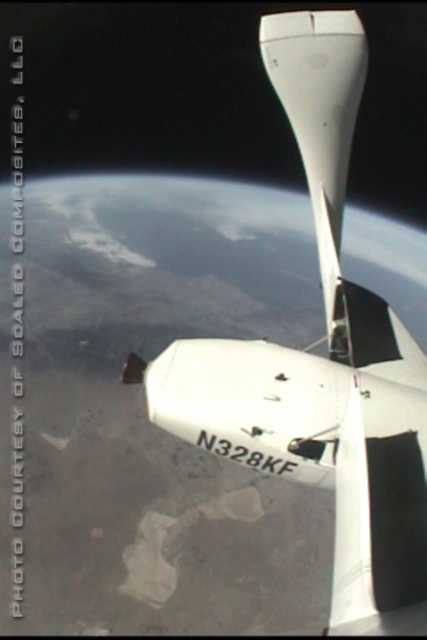|
|
Taken without permission from Aviation Week & Space Technology
June 7 2004 -Rob
Rutan tries for 100-km. suborbital flight with SpaceShipOne
Scaled Composites is opening its first attempt at a 100-km.
(328,000-ft.) suborbital flight, inviting the public to view the June 21
event from its Mojave, Calif., airport home base, from which the
SpaceShipOne craft will take off and land, and the rocket boost will be
visible.
Company founder Burt Rutan hopes a successful flight will accelerate
broader developments in space tourism. The plan is to next shoot for
the tourism-promoting Ansari X Prize by reaching 100km. with the added
weight equivalent of two passengers, and repeat the flight within two weeks.
The rocket glider reached 211,400 ft. on May 13 with a 55-sec.
firing of its hybrid solid rocket engine. Scaled expects to reach the
328,000-ft. design altitude with a full-duration 80-sec. burn just two
weeks from now.
The main novelties of the next flight are the longer burn, an
untried larger rocket nozzle, higher temperatures and Mach numbers, and
low dynamic pressure at burnout. The last two flights carried a full
load of hydroxyl-terminated polybutadiene rubber fuel in the rocket case
and nitrous oxide oxidizer in the tank behind the cockpit, and were at
nearly maximum gross weight. The rocket was shut off in mid-burn by
stopping the oxidizer flow, but the next flight will fully expend it.
SAFETY OF THE LONGER BURN was tested on the ground by taking a
rocket case that had gone through a full-duration run and firing it
again with a 100-sec. flow of nitrous oxide. This burned the remnants
of fuel, consumed the silica phenolic heat-resistant liner, and started
to smoke the carbon fiber/epoxy outer case, but did not penetrate it.
The larger nozzle has a higher expansion ratio that will yield more
thrust and efficiency at high altitude. It has not been tested on the
ground because it overexpands the exhaust there, leading to flow
separation and turbulence within the nozzle. Tests of the short nozzle
show that as the case structure around it warms up, the nozzle moves a
little bit, and motion sensors are part of the automatic shutdown safety
system.
The last flight reached Mach 2.5 during boost and heating was
recorded with temperatures a little less than expected. The red thermal
proctection coating on the leading edges, nose and belly of SpaceShipOne
was not damaged and remains in place for the June 21 flight, which is
expected to reach about Mach 3.5. However, peak equivalent airspeed
will not be any higher because the high Mach number will be achieved at
the edge of the atmosphere, where the equivalent airspeed is low. The
extra heat of higher Mach will damage the thin coating, which can be
replaced.
Control effectiveness was good on the last flight but roll-yaw
coupling made it difficult to fly. It achieved a super-sonic entry for
the first time, reach Mach 1.9 while in the "feather" configuration,
which pops up the aft wing and tail booms to enter at a high-drag
53-65-deg. body angle of attack. There were roll oscillations in
feather but they were slow enough that pilot Mike Melvill was able to
manually damp them. There is no fly-by-wire on SpaceShipOne. The
oscillations might be due to remaining liquid oxidizer sloshing in the
tank, but the tank will be emptied on the 100-km. flight.
The main control concern for the record flight is that the end of
the longer burn is occurring at the fringes of the atmosphere and
control authority to counter thrust asymmetries from nozzle erosion will
be weak because of the low equivalent airspeed. Add to this whatever
changes in control effectiveness there are with the higher Mach number.
The computational fluid dynamics says it is OK but the pilot will be
earning his salary. Attitude is controlled with cold gas jets during
the upward coast through vacuum, but they are very weak compared to a
conventional surface biting into thick air.
The May 13 flight was a big jump in envelope expansion by going to
Mach 1.9 from Mach 0.88 in feather configuration, as well as jumping to
Mach 2.5 from Mach 1.6 during the boost.
THE INSTRUMENT DISPLAY FAILED on that flight about one-third of
the way into the burn, but Melvill continued the trajectory by
referencing the horizon through the windows and was able to reach the
target apogee. The problem is believed to be the potentiometer that
adjusts display brightness - the calculations proceeded correctly but
the acceleration pulled the wiper off the contact. Once the motor
stopped, the display came back on. The pot has since been hard-wired.
The public flight to 100 km. is in contrast to prior tests, which
have been a private development program though brief flight test notes
have been posted on the web. "It's a legitimate 100-km. spaceflight,
done for the first time by a private firm instead of the government,
with a civilian as the commander," Rutan said. Information on attending
the event is at the Scalled web site, http://www.scaled.com
--

rutan2.jpg
|
|